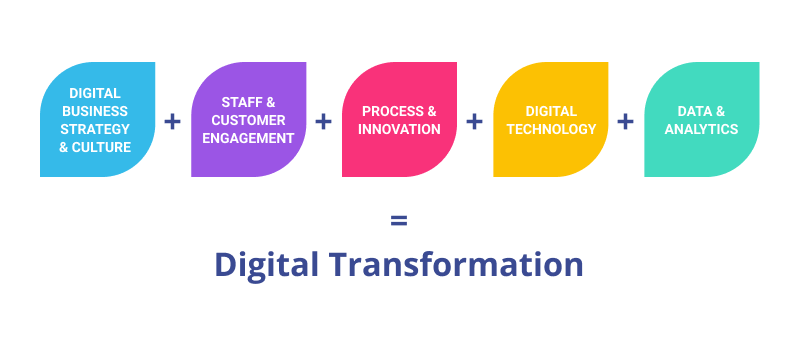Strategies for Successful Digital Transformation
Digital transformation is the process of integrating digital technology into all areas of a business, resulting in fundamental changes to how organizations operate and deliver value to customers. The pace of digital transformation is accelerating, and companies that fail to keep up risk being left behind. However, this is not simply a matter of implementing new technology. It requires a thoughtful strategy to ensure successful implementation and adoption. In this article, we will discuss strategies for successful digital transformation.

Why do you need a strategy for digital transformation?
A digital transformation is necessary for organizations to remain competitive and relevant in today’s digital age. How people communicate, shop, and interact with businesses has dramatically changed in recent years, with digital technology playing a central role. Customers now expect seamless and personalized experiences across all channels, and companies that fail to provide them risk losing customers to competitors that do. And no business can survive without new and recurring clients.
A digital transformation strategy helps organizations meet these changing customer expectations and stay ahead of the competition. By leveraging digital technology, businesses can streamline processes, improve efficiency, and create new business models that were not possible before. A digital transformation strategy enables organizations to collect and analyze data in real-time, providing insights to inform decision-making and drive continuous improvement.
Furthermore, digital transformation is not just about implementing new technology but also about transforming an organization’s culture, processes, and systems. A digital transformation strategy provides a framework for achieving this transformation in a structured and systematic way, ensuring all stakeholders are aligned and working towards a common goal.
Overall, a digital transformation strategy is essential for organizations that want to remain competitive and relevant in today’s digital age. It provides a roadmap for leveraging digital technology to improve customer experiences, drive innovation, and achieve business goals. Now that you already know why it is mandatory to have a clear strategy, we can talk more about how to come up with one.
How to build a successful strategy
Digital transformation is essential for organizations. However, simply implementing new technology is not enough. To achieve success, organizations need a clear strategy that aligns with their overall business goals and objectives and addresses digital transformation’s cultural and organizational challenges. Keep reading to explore the critical elements of a successful digital transformation strategy and provide practical tips on building and executing a strategy that delivers meaningful results.
Define clear goals and objectives
The first step in any successful digital transformation initiative is to define clear goals and objectives. These should be specific, measurable, achievable, relevant, and time-bound (SMART). Without clear goals and objectives, measuring the initiative’s success or aligning the efforts of different stakeholders will be difficult. Goals and objectives should be tied to the overall business strategy and reflect customer needs.
Develop a roadmap
Once goals and objectives have been defined, the next step is to develop a roadmap for achieving them. This should include a clear timeline, milestones, and plan for executing the initiative. The roadmap should be flexible enough to accommodate changes but specific enough to guide decision-making and resource allocation.
Secure buy-in from stakeholders
Digital transformation initiatives can impact multiple areas of an organization, so securing buy-in from all stakeholders is essential. This includes executives, employees, customers, and partners. Each stakeholder group may have different perspectives and priorities, so it is important to communicate the initiative’s benefits in a way that resonates with each group.

Foster a culture of innovation and experimentation
Digital transformation requires a culture of innovation and experimentation. This means encouraging employees to take risks and try new things, even if they fail. It also means creating a safe environment for experimentation and learning from failure. This culture should be supported by leadership and reflected in the organization’s values and policies.
Invest in digital skills and capabilities
Successful digital transformation requires a workforce with the necessary digital skills and capabilities. This may require upskilling existing employees or hiring new talent. It is important to identify the skills and capabilities needed for the initiative and to provide training and development opportunities to build them.
Leverage data and analytics
Data and analytics are critical for successful digital transformation. They provide insights into customer behaviour, operational performance, and market trends, which can inform decision-making and drive continuous improvement. Investing in the infrastructure and tools needed to collect, analyze, and act on data is important.
Collaborate with partners
Digital transformation often involves partnerships with other organizations. This may include technology vendors, startups, academic institutions, or industry associations. Collaboration can help accelerate innovation, share best practices, and create new business opportunities.

What makes a digital transformation strategy successful
A successful digital transformation strategy requires clear goals, strong leadership, collaboration, a culture of innovation, investment in digital skills, an agile approach, and a focus on customer experience. By focusing on these key elements, organizations can achieve the desired outcomes of their digital transformation initiatives and position themselves for success in the digital age.
In conclusion, digital transformation is a complex and ongoing process that requires a thoughtful strategy to ensure successful implementation and adoption. The steps outlined above can help organizations define a strategy with clear goals and objectives, develop a roadmap, secure stakeholders’ buy-in, foster innovation and experimentation, invest in digital skills and capabilities, leverage data and analytics, and collaborate with partners. By following these, organizations can position themselves for success in the digital age.
Thank you for checking out my article. I strive to provide you with high-quality articles that are both informative and engaging and will let you have a glimpse behind the curtains of digital transformation. Make sure to subscribe to my newsletter, so you’ll be the first to know about my latest publications and industry insights.

